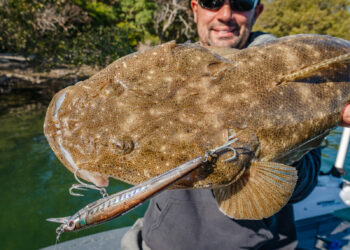BLUE swimmer crabs are arguably the tastiest crustaceans encountered by Aussie crabbers. These delicacies are commonly found throughout Australia’s estuaries and inshore regions in all mainland States. In Queensland they were officially known as sand crabs until recently, when officials switched names to the blue swimmer crab, as used in NSW and WA. In South Australia, they abbreviate this name even further to blue crabs, a name which alludes to the brilliant mottled blue colours of the adult males. In contrast, females are a drab mottled brown colour.
For a long time it was thought that only one species of blue swimmer crab occurred in Australian waters, namely Portunus pelagicus, a species which occurs in many countries bordering the Indian and Western Pacific Oceans from Japan throughout SE Asia, to India and the Red Sea. The species name pelagicus denotes they are an actively swimming crab, adults of which spend a fair proportion of their time in the water column.

A close up of a sand crab, Portunus armatus (southern blue swimmer crab), complete with barnacles.
However, in 2010 scientists from Singapore and Australia published a new study on blue swimming crabs from the Asian-Pacific region that turned conventional thinking about this species on its head. They found that crabs variously described as P. pelagicus were in fact, a species complex consisting of no less than four different species. Their study determined that the majority of blue swimmer crabs in Australian waters were not P. pelagicus at all, but were in fact the closely related Portunus armatus which was originally described from Shark Bay in WA in 1861.
It turns out that P. pelagicus is a tropical species that is only known to occur in Australia around Darwin in the Northern Territory. In contrast P. armatus was recorded from New Caledonia and all over mainland Australia, including the NT, which is the only area where both P. pelagicus and P. armatus coexist. The “true blue” Aussie swimmer crab P. armatus can be differentiated from its tropical cousin by virtue of the different colour patterns on its upper carapace (which are only really obvious when you have the two species side by side), and the fact that P. armatus has four spines along the front of its inner claw arms, while P. pelagicus only has three.
Male P. armatus grow to around 22 cm carapace width and up to 1 kg, while females tend to grow to a slightly smaller maximum size. In Queensland where P. armatus have been well studied, spawning occurs throughout the year, but mainly in spring. Large female crabs around 15 cm carapace width can batch spawn upwards of 300,000 eggs and may spawn up to 3 times in a season. Spawning occurs in offshore waters, often around 50 metres in depth.

The “True Blue” Aussie swimming crab P. armatus which is found around the rest of Australia. P. armatus has a different colour pattern and four large spines along the front of its inner claw arms (arrows), while P. pelagicus only has three spines in the same area.
After a short larval period, the juvenile crabs settle in inshore areas over the summer months and can be particularly abundant near seagrass beds. This species grows rapidly and matures at one year old around 10 cm carapace width. This relatively small size at maturity helps the species absorb considerable fishing pressure, as most size limits (around 15 cm carapace width) are much higher than the size at maturity. Growth continues to be rapid after maturity, and it appears that this species can reach its maximum size in three years, and seldom lives longer than that. All species of blue swimmer crabs are opportunistic scavengers. Juveniles feed on a variety of small crustaceans, molluscs and other invertebrates they find on the sea floor, while adults tend to switch to larger prey, including polychaetes and even small fish.
In Queensland around 12 per cent of blue swimmer crabs are infected by a parasitic barnacle Sacculina granifera, which changes the appearance of infected crabs (male crabs begin to look like females), castrates them and prevents them from moulting. Studies have shown that the prevalence of Sacculina in Moreton Bay has remained virtually unchanged for the past 15 years, which is good news for those who love eating these sweet crustaceans. However, one worrying trend recently discovered by international scientists is that another protozoan parasite that causes fatal disease in these crabs (Hematodinium) has increased from less than two per cent prevalence in the 1990s to around 20 per cent last year in Moreton Bay. It is tempting to speculate that this tenfold increase in disease is related somehow to the ongoing decline in ecosystem quality in Moreton Bay, but only further research will determine if this is indeed the case.


















